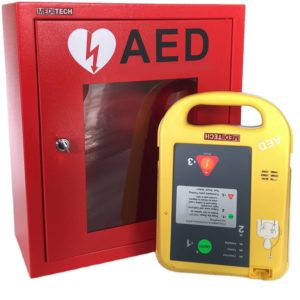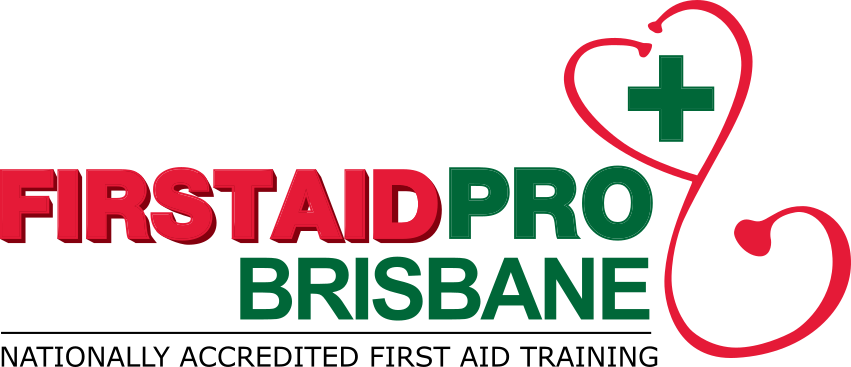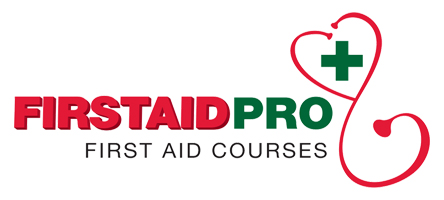Defibrillator
The defibrillator is used when the heart rate needs to be brought back to normal during a cardiac arrest episode. To be qualified to operate a defibrillator, you will first need to undergo adequate training, including first aid certification. FirstAidPro Brisbane offers this type of education, where the defibrillator’s use and functions are covered in-depth. You can see our current course schedule here.
Being certified in first aid and CPR is crucial before attempting to use this piece of equipment, as it can be dangerous if not used correctly.

When to use a defibrillator
Defibrillation is a treatment used for:
- Life-threatening cardiac dysrhythmias
- Ventricular fibrillation (VF)
- Non-perforating ventricular tachycardia (VT)
If a heart stops suddenly, a defibrillator is a device that is used to restore the heartbeat by delivering an electric pulse or current (often called an anti-shock) straight to the heart.
They are also used for:
- Arrhythmias
- Heart palpitations
- Sudden cardiac arrest
- Correcting an abnormal heartbeat
Types of defibrillators
There are three types of defibrillators:
- Automated external defibrillator (AED)
- Implantable cardioverter-defibrillator (ICD)
- Wearable Cardioverter-defibrillator (WCD)
All three of these defibrillators’ fundamental purpose is to send an electric shock to the heart to restore a regular heartbeat.
What does a defibrillator do?
The different types of defibrillators, though they have the same base purpose, work in different ways.
The automated external defibrillators (AED) are the ones you may notice in many public places. This type of defibrillator is for use during emergencies, designed to save the lives of people experiencing sudden cardiac arrest.
The implantable cardioverter-defibrillator (ICD) is what it sounds like, and a device is implanted to monitor the patient’s heart constantly. It is similar to a pacemaker and can detect ventricular fibrillation, ventricular tachycardia, supraventricular tachycardia, and atrial fibrillation. It automatically gauges the voltage of shock needed to restore normal cardiac function when it detects an irregular rhythm.
The wearable cardioverter-defibrillator (WCD) is a portable external defibrillator generally used with patients who are not in immediate need of an ICD. This device monitors the patient 24-hours-a-day. It only functions when it is worn, sending a shock to the heart whenever needed.
How to use a defibrillator on an adult

Required steps to use an automated external defibrillator (AED) on an adult:
- Turn on the AED and follow the visual and/or audio signal.
- Take off the person’s shirt and dry their chest so no moisture remains.
- Attach the AED pad, and plug in the connector.
- Make sure that no one, including yourself, is touching the patient. Ask everyone to “stand up”.
- Press the “Analyse” button and allow the AED to analyse the person’s heartbeat and detect the condition.
- If the AED suggests that you need to deliver a shock to the person, you must make sure no one, including yourself, approaches them and then press the button.
- Start CPR after the shock. Or, if a shock isn’t necessary, start CPR.
- Perform two minutes of CPR consisting of five cycles. Follow the AED signals.
- If you notice obvious signs of life, stop CPR and monitor breathing for any changes in the condition.
Pacemaker vs. Defibrillator
A pacemaker is a small device implanted in a patient’s chest to help control their heartbeat. It prevents the heart from beating too slowly. Implanting a pacemaker requires a surgical procedure.
An implantable cardioverter-defibrillator (ICD) is a small battery-powered device implanted in your chest to detect and stop abnormal heartbeats (arrhythmias). An ICD continuously monitors your heartbeat and delivers electric shocks, when needed, to restore your hearts rhythm to normal.
Cardiac Arrest
What is cardiac arrest?
Cardiac arrest is a condition in which there is a sudden loss of blood flow, resulting in the heart failing to pump effectively. Signs include loss of consciousness and abnormal or the absence of breathing. Some people may experience chest pain, shortness of breath, or nausea before cardiac arrest begins.
In most cases, cardiac arrest occurs when a patient’s heart’s system malfunctions. This disorder can cause abnormal heart rhythms such as ventricular tachycardia or ventricular fibrillation. Sometimes cardiac arrest can occur due to weak heart rhythms.
Signs of cardiac arrest
- Chest pain or discomfort
- Heart palpitations
- Rapid or irregular heartbeats
- Unexplained wheezing
- Shortness of breath
- Fainting
- Lightheadedness or dizziness
Is a defibrillator required during sudden cardiac arrest?
Sudden cardiac arrest (SCA) is when the heart malfunctions and suddenly stops beating unexpectedly. A defibrillator offers the best chance of survival against SCA since it sends an electric shock into the heart to help the heart restore its normal rhythm. Knowing how to use a defibrillator properly could help you save the life of a loved one.
Every student can practice AED during the CPR First Aid Course:
We pride ourselves on training students in our courses to the highest standard. We provide hands-on training, and you will use and become comfortable using an AED during your course. You will also learn how to execute CPR without the assistance of an AED.
FirstAidPro is nationwide, ensuring a training venue is conveniently near you, making learning first aid and CPR easier than ever.
Sudden cardiac arrest symptoms:
- Chest pain or discomfort
- Feeling weak, light-headed, or faint
- Pain or discomfort in the jaw, neck, arms or back
- Pain or discomfort in shoulders
- Shortness of breath
Available CPR Courses
We offer first aid and CPR courses seven days a week, making certification more accessible to everyone than ever before! Don’t wait. Register for your course today and help make your community safer.
- Register online
- Call us on 08 7120 2570
- Questions? Send us a message here!
Price Match Guarantee
Worried you’ll find a better price elsewhere? Even though we’re confident that we have the lowest prices around, we’ll price match if you manage to find a course for less!
Still not convinced? You’ll receive your CPR certification the same day of successfully completing your course.
FirstAidPro Brisbane is a Registered Training Organisation (40407). Rest assured that when you complete your training course with us, it’s recognised nationally.


